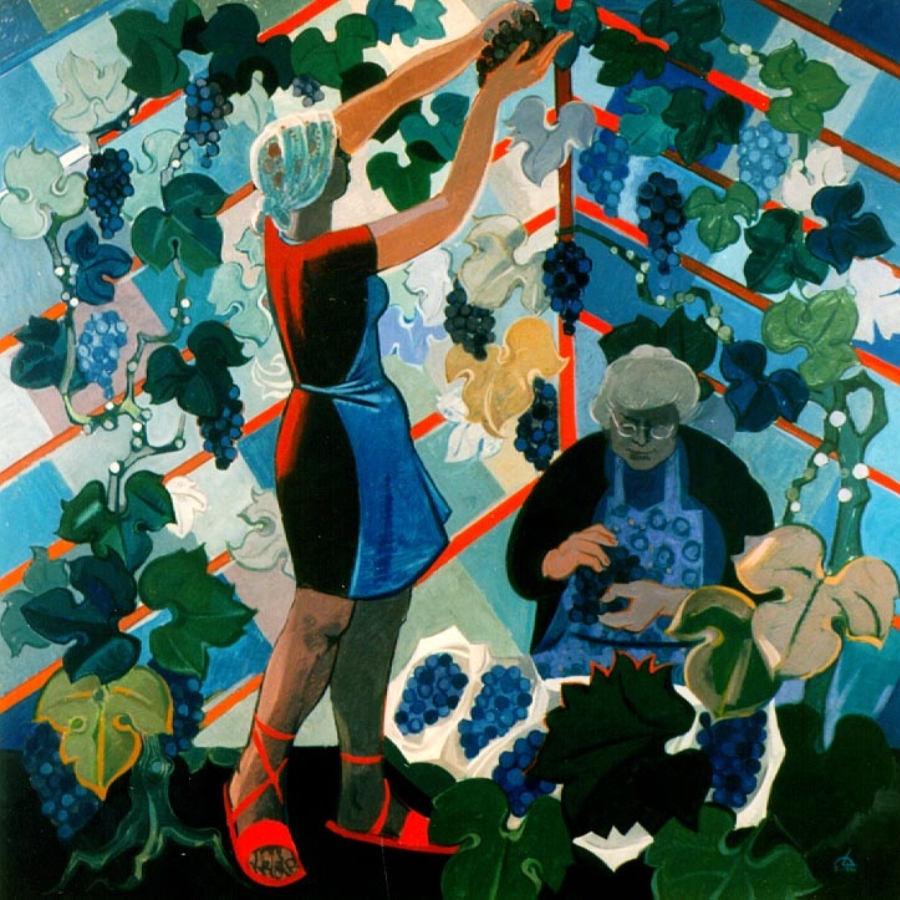Inhoud
- Biografie
- Schilderijen
- Tekeningen
- Gravures
- Tapijtontwerpen
- Sculpturen
- Van schets tot schilderij
- Bekijk de volledige collectie van Louis Deltour in de onlinecatalogus
Biografie
© Amsab-ISG
Louis Deltour werd geboren op 23 juli 1927 in Guignies, een klein dorp in de buurt van Doornik. Zijn vader was metser, zijn moeder huisvrouw. Op veertienjarige leeftijd schreef hij zich in aan de Academie voor Schone Kunsten van Doornik. Tijdens de Tweede Wereldoorlog sloot hij aan bij de Groep 60 van het Geheim Leger, waarmee hij deelnam aan een reeks sabotageacties. Hij illustreerde ook een clandestien tijdschrift.
Na de oorlog volgde Deltour les bij Charles Counhaye aan de Ecole nationale supérieure d’ Architecture et des Arts décoratifs de la Cambre te Brussel. Hij maakte er kennis met Edmond Dubrunfaut en Roger Somville. In 1947 stichtte het trio kunstenaars het Centre de Rénovation de la Tapisserie de Tournai en de groep Forces Murales. Geïnspireerd door zowel de Mexicaanse muralisten als door de aloude tapijtkunst, en aangemoedigd door verschillende publieke opdrachten, maakten zij monumentale werken over “het leven en het werk van de mensen, hun strijd, hun lijden, hun vreugde, hun overwinningen en hun hoop”.
In het begin van de jaren 1950 werd Deltour lid van de Kommunistische Partij. Hij was actief in de Brusselse afdeling van de jongerenbeweging. In 1952 ontmoette hij daar Jacqueline Brankaer, een Vlaamse onderwijzeres, met wie hij trouwde en twee zonen kreeg, André en Philippe.
In 1953 verliet hij de groep Forces Murales, maar hij bleef werken rond thema’s die nauw aansloten bij die van zijn vroegere kameraden (de mijnramp van Marcinelle, arbeiders in de bouw, de vredesbeweging…). In 1961 werd Deltour leraar aan de Academie voor Schone Kunsten van Doornik. Van 1973 tot 1980 engageerde hij zich, samen met enkele oud-leerlingen en zijn zoon Philippe, in het collectief Art et travail. Ook met Art et travail zette hij zich in om kunst op publieke plaatsen te tonen.
Zijn echtgenote overleed vroegtijdig in 1981.
Trouw aan zijn engagement koos Louis Deltour ervoor om in de luwte te werken, ver weg van kunstgalerijen en allergisch voor elke vorm van commercie. Hij creëerde talrijke figuratieve werken rond de thematiek van arbeiders en boeren, het dagelijks leven en de sociale strijd. Hij stelde alleen tentoon op voor iedereen toegankelijke plaatsen: volkshuizen, buurthuizen, scholen, enz. Dit verklaart wellicht waarom zijn werk nooit de aandacht kreeg die het verdiende en onbekend bleef bij het grote publiek. Tot aan zijn overlijden op 9 januari 1998 bleef zijn kunst altijd doordrongen van een diep humanisme.
Lees het artikel van Benny Madalijns over Louis Deltour in Brood&Rozen 2008/1
Schilderijen
© Amsab-ISG
Tekeningen
© Amsab-ISG
Gravures
© Amsab-ISG
Tapijtontwerpen
© Amsab-ISG
Sculpturen
© Amsab-ISG
Van schets tot schilderij: la genèse d'un tableau
© Amsab-ISG
Wil je meer werk van Louis Deltour in onze collectie zien?
Klik dan hier om naar onze onlinecatalogus te gaan
"Louis Deltour ou la faucille dans l'arc-en-ciel" Robert Remy
"L'artiste doit devenir un homme du peuple,un homme parmi les hommes" Camille Baillargeon








